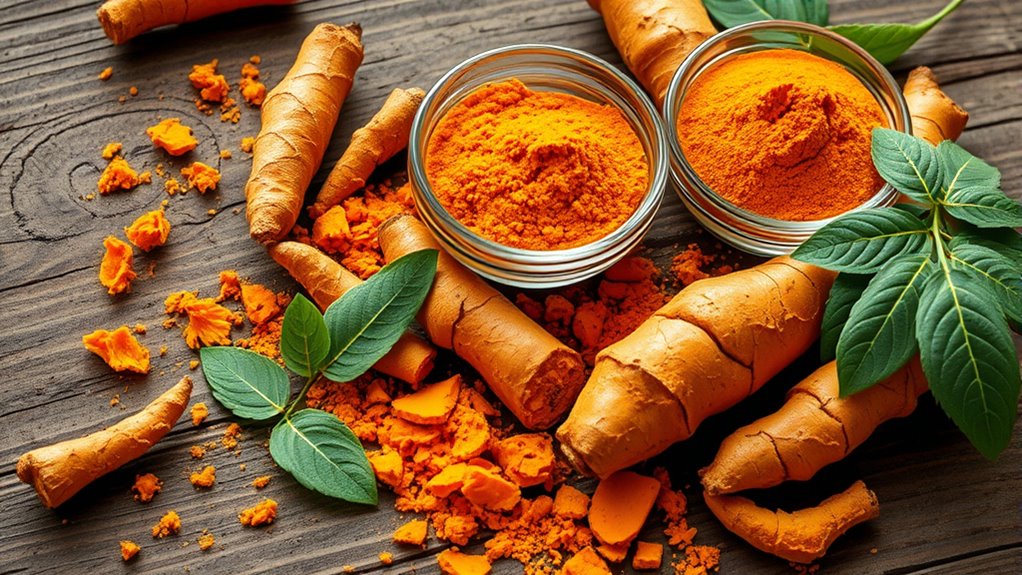Turmeric and curcumin are natural compounds known for their strong anti-inflammatory and immune-regulating effects. They work by blocking key pathways like NF-κB and reducing inflammatory enzymes and cytokines. These properties help manage conditions like arthritis, skin issues, and cardiovascular health. Despite their benefits, low bioavailability can limit their effectiveness, but advanced delivery methods are improving absorption. To discover how these powerful natural agents can support your health, keep exploring their full potential.
Key Takeaways
- Curcumin, the active compound in turmeric, modulates inflammatory pathways like NF-κB and inhibits enzymes such as COX-2.
- It reduces pro-inflammatory cytokines (TNF-α, IL-6, IL-8), lowering inflammation and immune activation.
- Curcumin’s antioxidant properties scavenge reactive oxygen species, decreasing oxidative stress linked to inflammation.
- Advanced delivery systems improve curcumin’s bioavailability, enhancing its systemic anti-inflammatory effects.
- Clinical studies support turmeric’s efficacy in managing inflammatory conditions like osteoarthritis and skin disorders.
The Composition and Active Ingredients of Turmeric
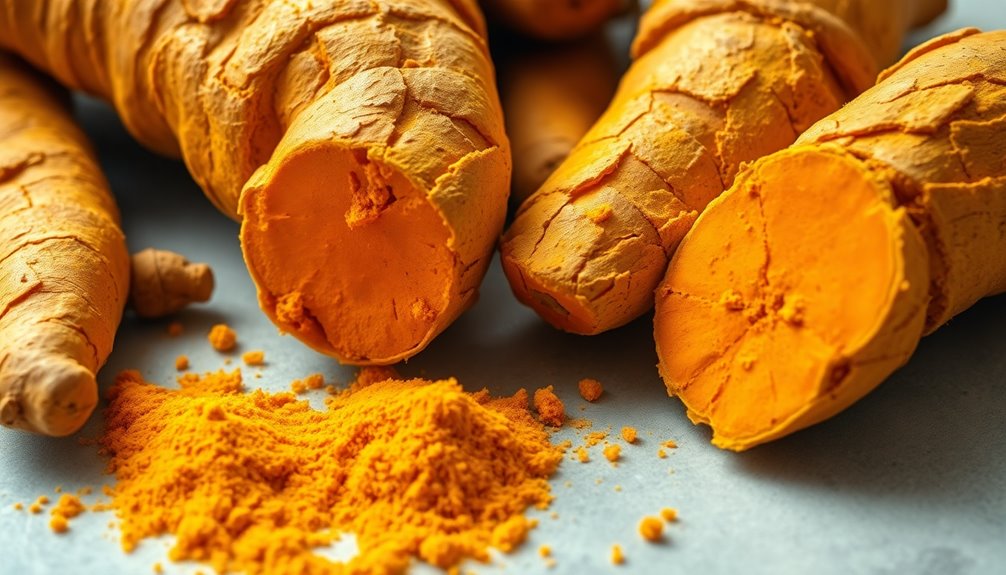
Turmeric powder is a complex spice that contains a variety of active ingredients contributing to its health benefits and vibrant color. About 60–70% of it is carbohydrates, with 6–13% moisture, while proteins make up 6–8%, and fats account for 5–10%. It also provides essential minerals like potassium, calcium, iron, sodium, and phosphorus, totaling around 3–7%. The spice contains 3–7% essential oils, mainly terpenoids such as turmerone and zingiberene, which give it aroma and potential therapeutic effects. Turmeric also includes 2–7% dietary fiber, along with minor phytochemicals like phenolic acids and flavonoids, such as gallic acid and rutin. The most notable active compounds are curcuminoids, especially curcumin, responsible for turmeric’s golden-yellow hue and antioxidant properties. bioactive compounds such as curcumin play a crucial role in its anti-inflammatory effects. Additionally, the presence of bioactive compounds enhances turmeric’s reputation as a health-promoting spice, and ongoing research continues to uncover new therapeutic benefits associated with its use. Recent studies also suggest that market demand for turmeric and curcumin supplements is increasing due to their widespread health claims.
How Curcumin Combats Inflammation
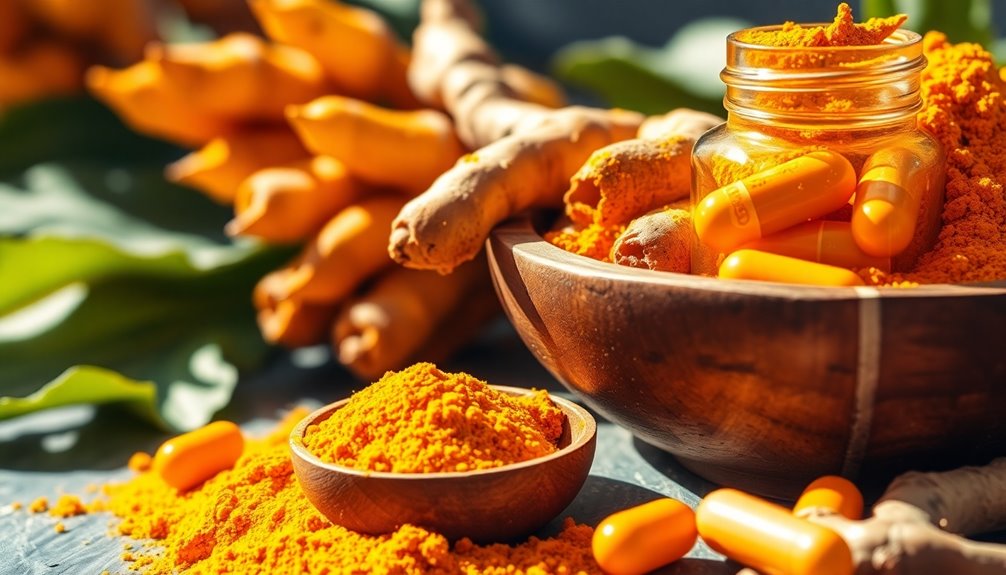
Curcumin, the powerful active compound in turmeric, combats inflammation through multiple mechanisms that target the root causes of inflammatory responses. It modulates key signaling pathways like NF-κB and TLR4, reducing the production of pro-inflammatory cytokines such as TNF-α, IL-6, and IL-8. Curcumin also inhibits inflammatory enzymes including COX-2, iNOS, and LOX, decreasing prostaglandins, nitric oxide, and leukotrienes that drive inflammation and pain. Additionally, it dampens immune cell activation, notably macrophages and monocytes, preventing excessive cytokine release. Its antioxidant properties further help by scavenging reactive oxygen species, lowering oxidative stress and tissue damage. Furthermore, research indicates that curcumin’s anti-inflammatory effects are enhanced when combined with other natural compounds, making it a versatile agent in reducing inflammation at multiple levels. Including healthy diet choices such as water-rich foods can further support anti-inflammatory processes, complementing the effects of curcumin. Incorporating a balanced intake of fruits and vegetables can provide additional antioxidants that bolster its benefits.
The Role of Curcumin in Immune System Regulation
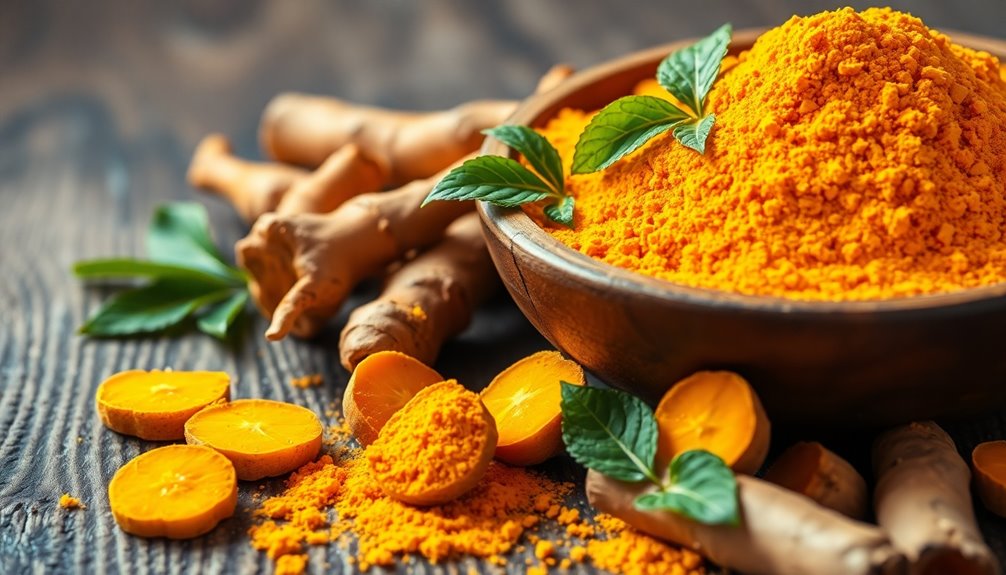
Have you ever wondered how natural compounds influence immune regulation? Curcumin plays a crucial role by modulating both innate and adaptive immunity. It inhibits regulatory T cells, boosting effector T cell activity and increasing interferon-gamma production. Curcumin also promotes the conversion of Tregs to Th1 cells, enhancing immune responses. It suppresses Th1 cytokine production by blocking IL-12 in macrophages and reduces dendritic cell antigen presentation, preventing overactivation. Additionally, curcumin dampens inflammation by inhibiting cytokines like IL-12 and TNF-α, and signaling pathways such as NF-κB and MAPKs. It helps maintain immune balance, preventing hyperactivation and chronic inflammation. By regulating gene expression related to inflammatory mediators, curcumin guarantees immune responses remain effective without becoming damaging. Furthermore, understanding cultural intelligence is essential for harnessing the full potential of curcumin’s anti-inflammatory effects. Incorporating immune modulation strategies can further enhance its benefits in managing inflammatory conditions. Additionally, research indicates that epigenetic regulation plays a significant role in how curcumin influences gene expression related to inflammation and immunity. Recognizing the importance of targeted therapy approaches can optimize curcumin’s role in immune health.
Therapeutic Applications of Turmeric and Curcumin
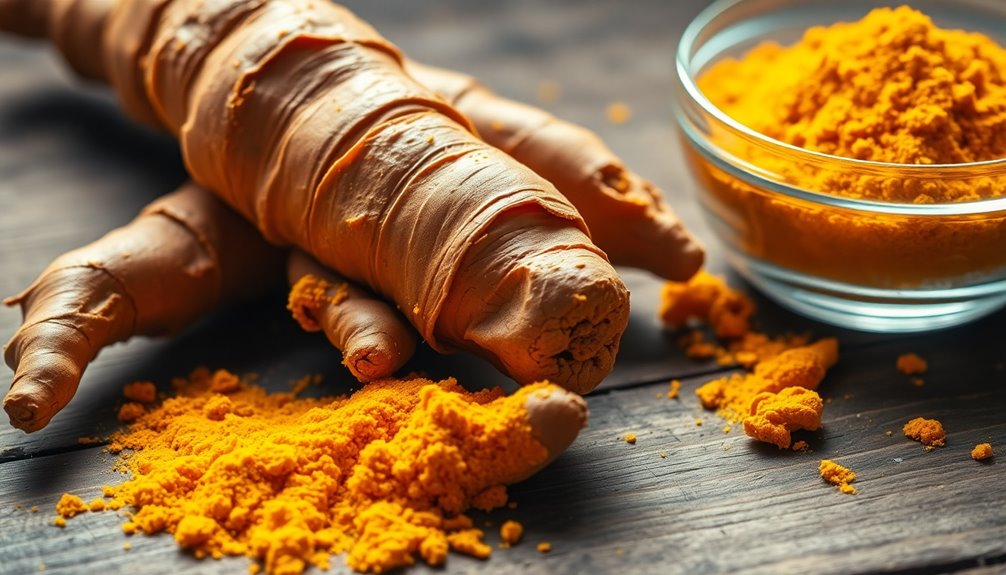
Building on curcumin’s ability to modulate immune responses, its therapeutic applications extend across a wide range of health conditions. Its strong anti-inflammatory properties help reduce swelling and pain in osteoarthritis, often matching ibuprofen’s effectiveness. Curcumin also manages inflammation-related skin issues like acne and eczema, and it’s used to prevent mouth sores during cancer radiation therapy. Its benefits aren’t limited to inflammation; curcumin may improve cardiovascular health by lowering triglycerides and protecting against oxidative stress. Additionally, it shows promise in cancer treatment, helping alleviate side effects like mucositis and radiation dermatitis. Curcumin’s antioxidant actions support liver health by reducing liver injury markers and preventing fat buildup in NAFLD. Overall, turmeric and curcumin serve as versatile agents in managing inflammation and supporting recovery.
The Antioxidant Benefits of Curcumin

Thanks to its unique chemical structure, curcumin acts as a powerful antioxidant that can neutralize free radicals and stimulate the body’s natural defenses. Its polyphenolic structure enables it to directly scavenge reactive molecules, preventing oxidative damage. Curcumin boosts total antioxidant capacity and tends to lower malondialdehyde levels, a marker of lipid peroxidation. It also enhances the activity of enzymes like superoxide dismutase, catalase, and glutathione peroxidase, strengthening your body’s defenses against oxidative stress. By maintaining redox balance, curcumin helps protect cells and tissues from damage associated with aging, metabolic syndrome, and inflammatory conditions. Its antioxidant properties support overall health, potentially reducing the risk of chronic diseases linked to oxidative stress and promoting systemic well-being.
Enhancing Bioavailability: Making Curcumin More Effective

While curcumin’s antioxidant power is impressive, its effectiveness depends heavily on how well your body can absorb it. To boost absorption, using piperine is a proven strategy—this compound inhibits glucuronidation, helping curcumin stay active longer in your system. Encapsulating curcumin in specialized formulations or creating nanoparticles enhances stability and solubility, making it easier for your body to utilize. The natural turmeric matrix also plays a role, improving bioavailability without additional ingredients. Formulating curcumin with phospholipids mimics natural lipid structures, further aiding absorption. These approaches address curcumin’s poor hydrophobic nature, rapid metabolism, and quick clearance. Additionally, incorporating bile salts can improve fat digestion and absorption of hydrophobic compounds like curcumin. Recognizing the bioavailability challenges associated with curcumin helps in designing more effective delivery systems, ensuring you receive maximum health benefits. Advances in delivery technologies are continually improving curcumin’s bioavailability, making it more effective as a supplement. Understanding enhanced delivery methods can significantly improve curcumin’s efficacy and health outcomes. By adopting these strategies, you markedly increase the likelihood that curcumin’s anti-inflammatory and health benefits will work effectively within your body, especially when combined with proper dietary fats to further promote absorption.
Current Evidence and Clinical Uses of Turmeric

Research shows that turmeric’s primary active compound, curcumin, provides notable anti-inflammatory effects by inhibiting molecules like cytokines and COX-2 enzymes, making it a promising option for managing conditions such as arthritis and joint disorders. You might find turmeric supplements helpful for osteoarthritis, as studies suggest they can reduce pain and improve mobility, sometimes matching the effects of NSAIDs but with fewer side effects. Turmeric is also used for rheumatoid arthritis, though evidence is less conclusive. Its traditional roles include supporting digestive and liver health, alleviating IBS and gut inflammation. Additionally, preliminary research hints at benefits for neurological and metabolic conditions, like Alzheimer’s and high cholesterol. Religious and spiritual principles emphasize gratitude and healing, which may enhance the holistic approach to using turmeric. Moreover, the anti-inflammatory properties of curcumin are being explored for potential benefits in other inflammatory diseases. Understanding the importance of road signs and their role in safety can help inform public health strategies and patient education campaigns. Regular use of quality supplements and proper dosing are essential for maximizing turmeric’s benefits while minimizing potential risks. However, more rigorous human studies are needed to confirm turmeric’s clinical effectiveness across these applications.
Limitations and Challenges in Curcumin Research
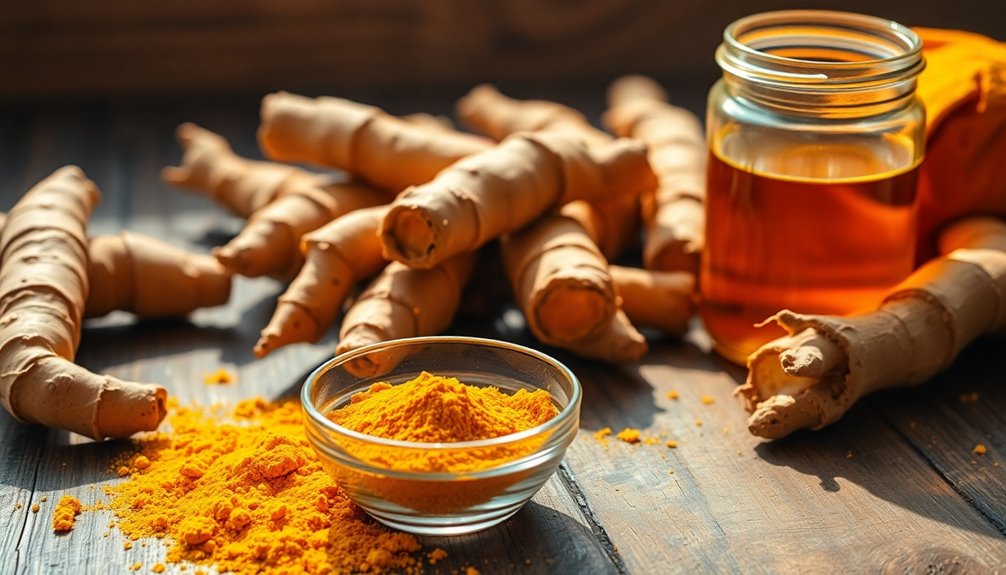
One of the main hurdles in advancing curcumin’s clinical applications is its poor bioavailability. You’ll find that curcumin has low water solubility, which hampers absorption in your gut. Additionally, it’s rapidly metabolized and eliminated, meaning only a small fraction reaches your bloodstream. The hepatic first-pass effect further reduces its systemic presence when taken orally. To improve this, bioavailability enhancers like piperine are often necessary. Variability in formulations and the lack of standardized dosing complicate clinical research, making it difficult to compare results or develop consistent treatment protocols. *Furthermore*, curcumin’s complex pharmacokinetics and unstable chemical structure pose challenges for both research and practical application. These issues limit its clinical translation despite promising anti‑inflammatory potential, underscoring the need for advanced delivery systems and standardized methods.
Potential Side Effects and Safety Considerations
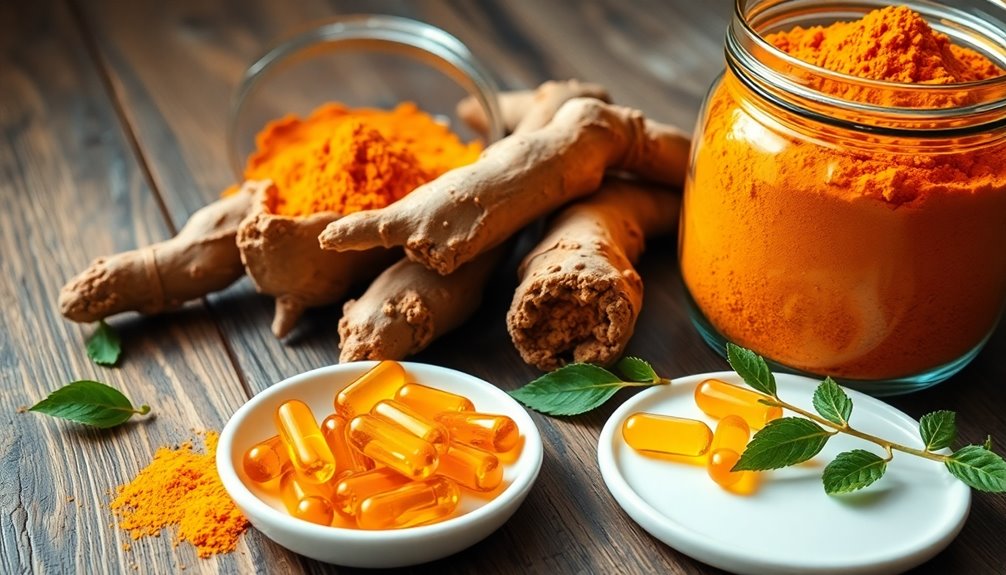
Turmeric and curcumin are generally safe when taken in appropriate amounts, but they can cause side effects and safety concerns, especially at higher doses or with long-term use. You may experience gastrointestinal upset, like nausea, diarrhea, or acid reflux, particularly with larger doses. They can also thin your blood, increasing bleeding risk, or trigger allergic reactions such as rashes or hives. If you have diabetes, turmeric might lower your blood sugar too much, so monitor closely. High doses of curcumin could harm your liver or kidneys, and it may worsen gallbladder issues. Be cautious if you’re pregnant, breastfeeding, or on medications like blood thinners or antidiabetics. Always follow dosage guidelines, take with food, and consult your healthcare provider for personalized advice.
Future Directions in Turmeric and Curcumin Research
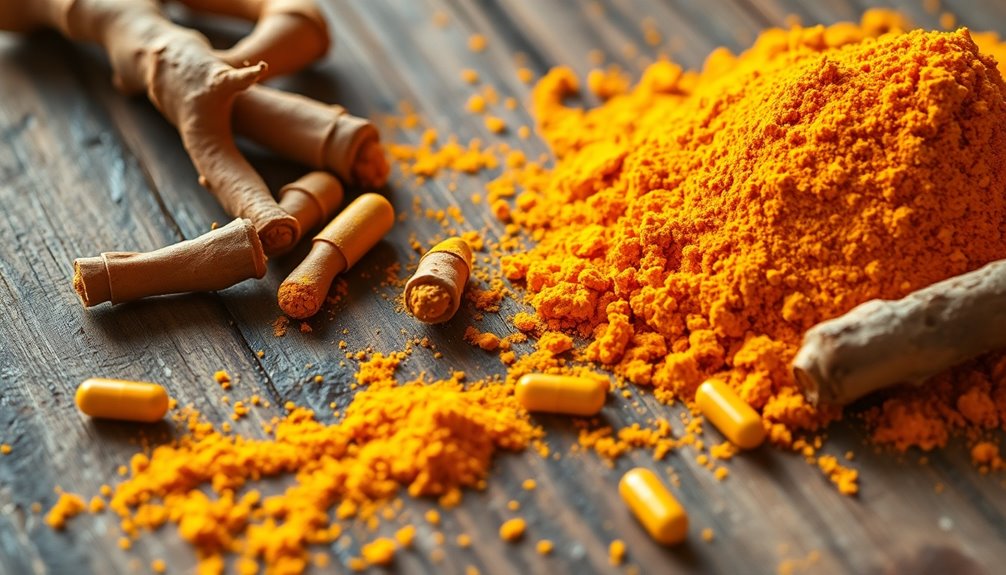
How can scientists overcome the challenge of curcumin’s poor bioavailability to maximize its therapeutic potential? Researchers are developing advanced delivery systems like liposomes, nanoparticles, and micelles to improve stability and absorption. Combining curcumin with other turmeric compounds can create synergistic effects that boost bioavailability, while targeted delivery aims to concentrate curcumin precisely in inflamed or cancerous tissues. Future efforts also focus on multi-carrier systems to enable controlled release and sustained circulation. Additionally, multi-omics approaches—such as genomics, proteomics, and metabolomics—are being used to uncover curcumin’s molecular mechanisms and identify biomarkers for responsiveness. Exploring curcumin’s role in emerging infectious diseases and integrating it into personalized medicine strategies could further expand its therapeutic applications, making it a more effective tool against chronic inflammation and related conditions.
Frequently Asked Questions
What Are the Differences Between Culinary Turmeric and Supplement Curcumin?
When comparing culinary turmeric to supplement curcumin, you’ll find that turmeric is a whole spice containing various compounds, with only a small amount of curcumin. Supplements concentrate curcumin for higher potency and often include absorption enhancers like piperine. While turmeric in food offers health benefits, supplements provide standardized, potent doses designed for therapeutic effects, often with fewer contaminants, making them more effective for targeted health benefits.
How Does Turmeric Interact With Common Medications and Health Conditions?
You should know that turmeric interacts with several medications and health conditions. It can increase bleeding risk if you’re on blood thinners or NSAIDs, so avoid it without your doctor’s advice. It might reduce the effectiveness of acid-reducing drugs and cause blood sugar dips if you take diabetes meds. Turmeric can also alter antibiotic absorption and interfere with iron supplements. Always consult your healthcare provider before adding turmeric to your routine, especially if you’re on medication.
Are There Any Specific Populations That Should Avoid Turmeric Supplements?
You should avoid turmeric supplements if you’re pregnant, breastfeeding, or scheduled for surgery. Also, steer clear if you have bleeding disorders, gallbladder issues, liver problems, or anemia. If you’re on blood thinners, diabetes medications, or iron supplements, consult your doctor first. Children and older adults with chronic conditions should also be cautious. In these cases, avoiding turmeric helps prevent potential health risks and interactions.
How Long Does It Take to See Health Benefits From Turmeric or Curcumin?
You’re wondering how long it takes to see health benefits from turmeric or curcumin. Typically, you’ll notice some improvements within 4 to 8 weeks of consistent use, especially for inflammation, joint pain, or mood. Factors like formulation, dosage, and bioavailability influence this timeframe. For noticeable results, stick with your supplement daily, and consider combining it with absorption enhancers like piperine for faster effects.
Can Turmeric or Curcumin Effectively Treat Chronic Inflammatory Diseases?
You’re wondering whether turmeric or curcumin can combat chronic inflammation effectively. While promising, they’re not miracle cures but may help manage symptoms when used consistently. Curcumin’s powerful properties target inflammatory pathways, potentially easing conditions like arthritis or inflammatory bowel disease. However, their effectiveness depends on proper dosing, bioavailability, and individual response. Combining these natural remedies with medical advice can create a complementary, caring approach to controlling chronic inflammation.
Conclusion
You now see how turmeric and curcumin pack a powerful punch against inflammation and support your immune health. With studies showing curcumin’s potential to reduce inflammatory markers by up to 50%, it’s clear these natural compounds hold promise. While research continues, incorporating turmeric into your diet may boost your wellness naturally. Just remember to consult a healthcare professional, especially if you’re on medication, to enjoy its benefits safely.
